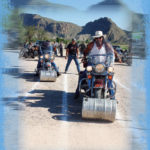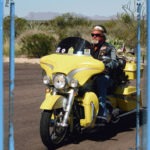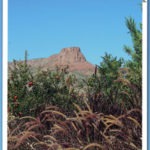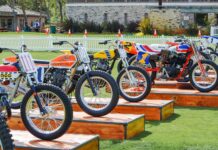Rally by the Rio
Where the cacti run for shade
Lajitas, Texas, Oct. 16–17—Some people look at this arid countryside and label it melancholy and desolate. I view it as serene and majestic. But no matter which side of the barbwire you stand on, no one can deny its beauty. The Big Bend area of Texas is one of the most pristine locales in a state heavily laden with pristine. Its nearest competitor is the fabled Hill Country. But the two regions are about as diametrically opposed as it’s possible to be. While the Hill Country is resplendent in woods and rivers, the sparseness of Big Bend challenges even the most rugged. But despite the arduous conditions, each fall a group of hardy souls carve a niche in the desert sands and cactus, cobbling together an event that area bikers look forward to all year.
For the first time in many years, the Ride for Trails was slated to be held in Lajitas, a popcorn fart of a town perched on the banks of the Rio Grande River just west of Big Bend National Park. But despite its diminutive size, Lajitas is rich. For years Lajitas had languished along the Mexican border, a guarded secret to a wizened few and completely unknown to most. That was the period of time when the rally was welcomed within the city limits. But after a few years, when Dallas entrepreneur Stephen Smith bought the town, the rally was given the boot. Yes, Lajitas was privately owned and Smith purchased the 25,000-acre parcel with the intention of molding it into a high-dollar luxury resort patterned along the lines of Palm Springs. He tagged it the Ultimate Hideout and built an airstrip, a golf course and other luxury amenities. But West Texas ain’t California and tossing money around did little to tame this unforgiving land. (In the process he screwed up the delicate ecosystem pretty good, too.) In 2007, Smith declared Chapter 11 bankruptcy on the project. He was never able to regroup and the town changed hands once again in 2009.
The new owners are biker-friendly, having dropped the previous owner’s air of snobbery. They welcomed RFT back to the rally’s birthplace by also dropping the prices for lodging, resulting in a sellout of all the resort’s suites—a lesson other rally sites should consider.
But travel to this picturesque nugget of solitude is not a painless task. Big Bend National Park is a place far-flung, and getting here is never an accident. You do not just “pass through.” If you reside within a 100-mile radius of the park, you’re considered a local rider and damn near every other rider knows you. From Houston, my ride covered more than 650 miles, included several border patrol checkpoints and took two days, passing through the northern edge of the Chihuahuan Desert and slicing between the Guadalupe and Chisos Mountain ranges. And as is usual for most arriving riders, I took advantage of a sparse Friday event schedule, riding the twisting road to the Basin in the heart of the National Park and tracing the course of the Rio Grande as far as Presidio. That was followed by getting checked into my room along the town’s boardwalk and a soothing bath in the finest accommodations I’ve enjoyed in quite a while. I ended my first night at the Thirsty Goat Saloon with “locals” I hadn’t seen in a year, toasting each other with frosty mugs and questionable behavior.
Saturday morning saw the first bike head out on the Rally’s poker run at 8:00. Although the route is familiar and the same one used for years, it has never become boring—leave Lajitas, make your first stop at the Terlingua Ghost Town and the Terlingua Trading Company, continue on to the “mall” in Study Butte (combination grocery, deli-shop and liquor store), ride into the National Park with a stop at the stunning Soto Vista Overlook, up into the Basin for card number four, and end at the Park HQ in Panther Junction. Last bike on the poker run was supposed to be back into the Lajitas Trading Post by 2:00 that afternoon in time for the bike show and biker rodeo. But this is a laid-back region that pays little attention to schedules, so it was almost 3:00 before the last of the stragglers came motoring into the dusty lot at the Trading Post.
I normally could care less about schedules except this year I was sponsoring the bike show; providing trophies and making arrangements with the resort for a Best of Show, grand-prize weekend package for two. Plus I was a bike show judge along with Ernest, a noted bike shop proprietor with Big Bend Cycle out of Alpine. After corralling all the contestants together and classifying each bike into one of six categories, we got down to serious business: having each owner show us the intricacies of his bike, taking note of custom paint and unique parts and… accepting bribes in the form of liberal shots of Patron tequila (apparently a common practice along the border). Following the bike show was a duel in the dust, as bike rodeo participants competed in the slow race, a cone and ball balancing act and the traditional Old West wienie bite shootout. With encouraging shouts and hoots from the spectators, even the rodeo losers rode away winners.
This year’s Bike Parade to the Ghost Town had to be cancelled due to lack of time and the impending serving of the barbecue dinner at the amphitheater. So after a quick trip to wash off all the accumulated Trading Post grit, the assembled crew feasted on brisket and chicken and spent the remainder of the night dancing to the music of Los Pinche Gringos (The Stingy White-Boys).
My riding partner and I pulled out late Sunday morning after saying our goodbyes to the organizers while promising to do it again next year. We paused at the Terlingua Trading Company long enough for a cool beverage and to listen to some of the local residents spin yarns from the “liar’s bench” in the shade of the building’s front porch. After a quick breakfast of migas and peppers, we headed over to the Hot Springs on the far east side of Big Bend National Park. Established in 1909 as a health resort by J.O. Langford, the Hot Springs occur naturally, bubbling forth from near the banks of the Rio Grand on the Texas side. A skinny man wracked with malaria, Langford swore to the Hot Springs’ effectiveness in curing his affliction. Unfortunately the river was not exhibiting its typical meandering nature this day but, instead, an unusually high and rapid water flow. And while it was impossible to actually get into the Hot Springs, it was exhilarating to walk out on one of the resort’s crumbling walls and watch as the river rushed toward you, pounding at your feet. I then showed my gal the nearby Indian pictographs and we explored the ruins that remain of the resort’s lodgings and general store. We also said our prayers and left some pesos for the children across the river in the village of Boquillas. The residents there eke out a meager, riparian existence made even more difficult since the border crackdown by Homeland Security after 9/11. The villagers cross the river illegally and leave agate stones, woven trinkets and carved walking sticks along with a donation jar asking for help to buy books for the local school.
The only time melancholy ever threatens while visiting this region of Texas is when it comes time to leave this colorful and magic frontier. But despite heading east to the cold steel and concrete of Houston, we carried a saddlebag of warm and dusty memories that would tide us over until our next ride west to the Big Bend.






















